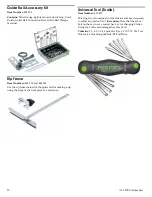
Instruction Manual
17
Maintenance
Routine Maintenance
Any maintenance or repair work that requires opening of
the motor or gear housing should be carried out only by an
authorized Customer Service Center (name supplied by your
dealer)! Maintenance or repair work carried out by an
unauthorized person can lead to improper connection of
electrical wires or other components, which can result in
injury.
To prevent injury or electrocution, always unplug the tool
from the power supply outlet before performing any
maintenance or repair work on the tool!
Do not use compressed air to clean the motor housing of the
tool, as you could inject foreign objects into the motor
through the ventilation openings. Compressed air may be
used on other components, but personal safety protection
should be employed (hearing, vision, and respiratory).
Certain cleaning agents and solvents are harmful to plastic
parts. Some of these include, but are not limited too:
Gasoline, Acetone, Methyl Ethyl Ketone (MEK), Carbonyl
Chloride, cleaning solutions containing Chlorine, Ammonia,
and household cleaners containing Ammonia.
To ensure proper cooling of the tool and motor, the cooling
vents in the motor housing must always be kept clear and
clean.
Keep the Saw Clean
Dust and debris from some materials can be extremely
abrasive and cause components within the saw to wear
prematurely. It is important to keep moving parts cleared of
abrasive dusts.
►
As a general rule, keep the saw clean of all dust and
debris. Even soft-wood dust can be abrasive over time.
►
Examine all moving parts for dust and debris.
►
Keep the bevel hinges (figure 13) clean of dust using
compressed air or cotton swabs. If the hinges wear due to
abrasive particles, the saw will not perform optimally.
►
Keep the blade area and dust extraction ports clean of
debris. Debris can cause wear and reduce the effectiveness
of the dust extraction system.
Keep the Sawblades Sharp
Using a dull sawblade can be extremely dangerous and
provide poor cut quality.
►
Never attempt to sharpen a sawblade manually. Special
equipment is necessary to properly sharpen a circular
sawblade. An improperly sharpened sawblade can injure
the operator, destroy the saw, and damage the workpiece.
►
The sawblades should be sharpened regularly, and only
by a qualified sharpening service.
►
Improper grinding of the carbide teeth of a sawblade can
result in serious injury to the saw operator.
Adjust and Inspect the Saw
To ensure the saw is in proper working order, periodically
inspect the operation of the saw and ensure it is properly
adjusted.
►
Observe the function of the saw during normal operation.
►
Unusual sounds are indicative of pending problems.
►
A reduction in the cut quality indicates the saw is either
improperly adjusted or not functioning properly.
►
A reduction in cutting power or speed may indicate a dull
blade or a motor problem.
►
If any of the safety devices on the saw are inoperable or
disabled, immediately stop using the saw and have it
serviced.
►
Periodically inspect the guide rail gibs for wear and
proper adjustment. If the gibs are worn or misadjusted, the
saw will not cut straight.





































